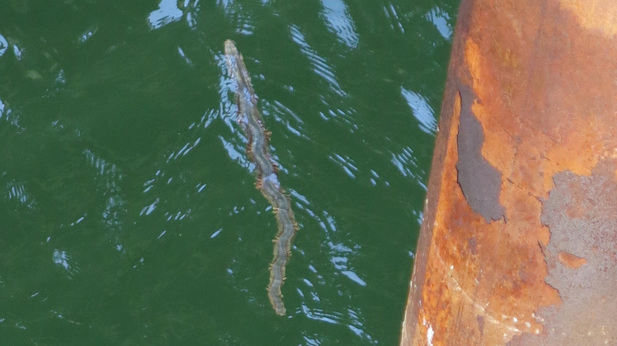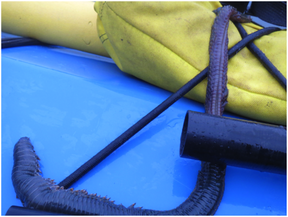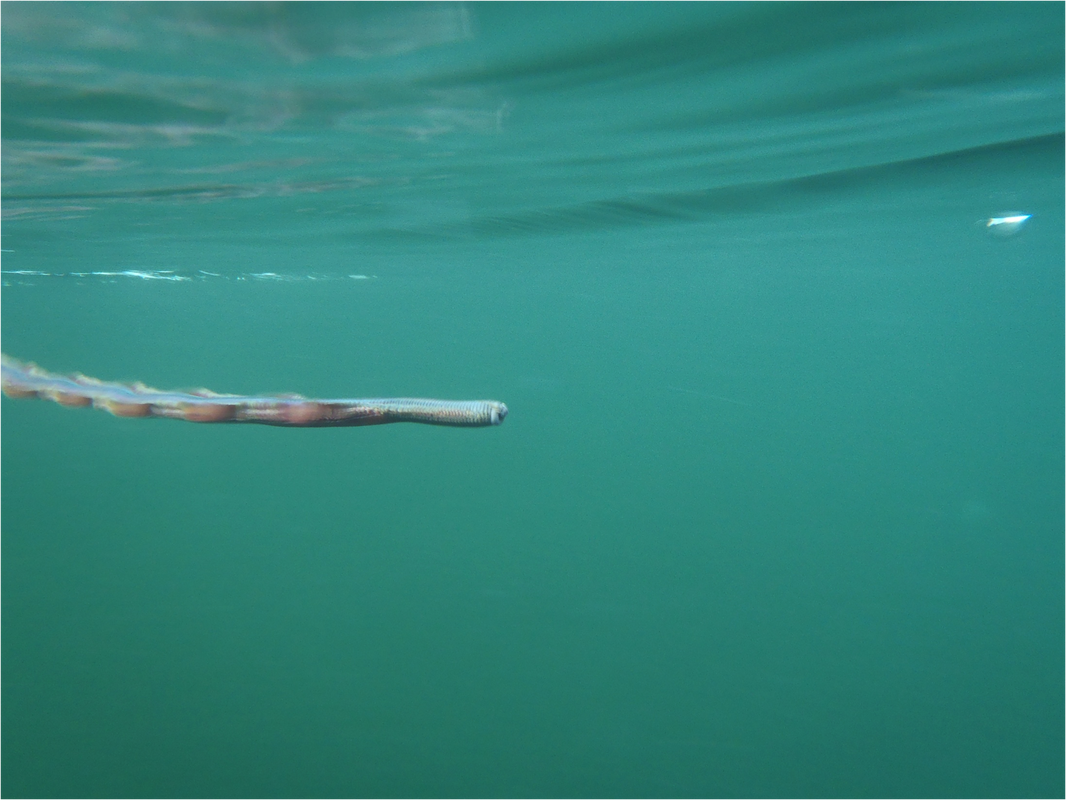Giant clam worm, giant piling worm, giant piling sea-nymph • Nereis brandti / Nereis virens
Identification
Nereis brandti and N. virens can only be differentiated by examination of small structures on the proboscis, and so are often grouped together for identification. These iridescent greenish-blue to brownish or greyish worms get to 1.5 m long. They have large paddle-shaped parapodia; the posterior parapodia bear prominent leaf-shaped lobes (termed ligules) that are raised along the body like waving banners or flags. They have enormous jaws that they can evert when disturbed. The video below shows this jaw eversion technique, as well as the worms' leaf-shaped ligules and iridescent colouring.
Habitat & Range
These species live in the intertidal and subtidal of mudflats and sandbars, where they are usually buried deep in sediment. They can be found in bays from northern Alaska to southern California.
Similar Species
The clam worm (Nereis vexillosa) is similar but smaller: it reaches a maximum of 30 cm long and has strap-shaped ligules.
Intriguing Info
Algae is a main food source - the giant jaws are mostly used for territory defense.
Nereis brandti and N. virens can only be differentiated by examination of small structures on the proboscis, and so are often grouped together for identification. These iridescent greenish-blue to brownish or greyish worms get to 1.5 m long. They have large paddle-shaped parapodia; the posterior parapodia bear prominent leaf-shaped lobes (termed ligules) that are raised along the body like waving banners or flags. They have enormous jaws that they can evert when disturbed. The video below shows this jaw eversion technique, as well as the worms' leaf-shaped ligules and iridescent colouring.
Habitat & Range
These species live in the intertidal and subtidal of mudflats and sandbars, where they are usually buried deep in sediment. They can be found in bays from northern Alaska to southern California.
Similar Species
The clam worm (Nereis vexillosa) is similar but smaller: it reaches a maximum of 30 cm long and has strap-shaped ligules.
Intriguing Info
Algae is a main food source - the giant jaws are mostly used for territory defense.
References
Cowles, D. (2005). Nereis (Neanthes) brandti (Malmgren, 1866). Invertebrates of the Salish Sea. Rosario Beach Marine Laboratory. Accessed 10/10/2014.
Harbo, R. M. (2011). Whelks to whales: Coastal marine life of the Pacific Northwest. Madeira Park, BC: Harbour Publishing. P. 78.
Lamb, A., and Hanby, B. (2005). Marine Life of the Pacific Northwest [electronic resource]. Madeira Park, BC: Harbour Publishing.
Authors and editors of page
Kelly Fretwell and Brian Starzomski (2014).
Cowles, D. (2005). Nereis (Neanthes) brandti (Malmgren, 1866). Invertebrates of the Salish Sea. Rosario Beach Marine Laboratory. Accessed 10/10/2014.
Harbo, R. M. (2011). Whelks to whales: Coastal marine life of the Pacific Northwest. Madeira Park, BC: Harbour Publishing. P. 78.
Lamb, A., and Hanby, B. (2005). Marine Life of the Pacific Northwest [electronic resource]. Madeira Park, BC: Harbour Publishing.
Authors and editors of page
Kelly Fretwell and Brian Starzomski (2014).






